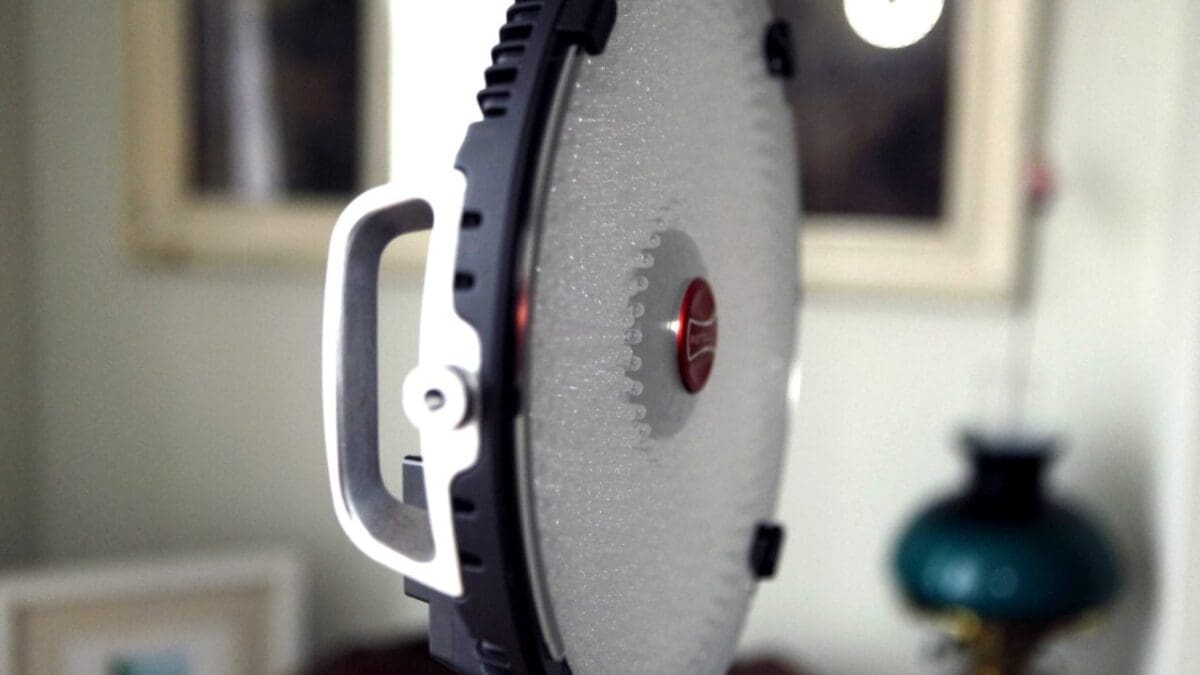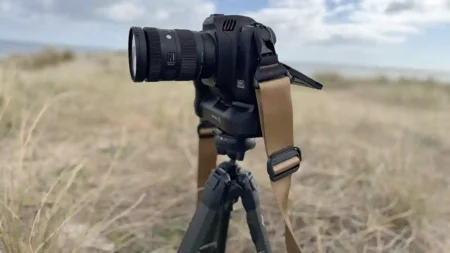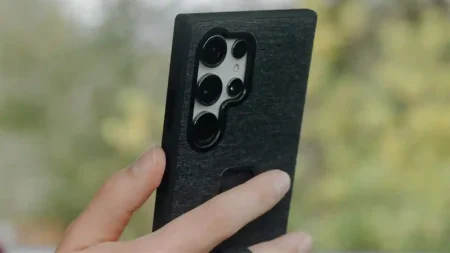Rotolight AEOS Snap Verdict
Quite unlike the mass of other LED lighting panels on the market the AEOS is aimed at both videographers and photographers alike and offers both constant and flash lighting.
The powerful LEDs throw a decent fall of light and the round design creates attractive catchlights. Features such as a flash sync port for wireless flash capabilities for photographers and lighting effects modes for videographers elevate the AEOS above the competition.
For Rotolight AEOS
- Powerful illumination
- Built-in flash
- Temperature adjustment
Against Rotolight AEOS
- Battery is an additional cost
- No app connection
- Flash not as powerful as traditional units
Based at the world famous Pinewood studio’s Rotolight has established itself as a dominant force in film and photography lighting. Driven forward by an impassioned team that have innovated to produce a series of great looking constant lights that offer true versatility for today’s photographers.
The AEOS is the latest Pro level light from the company, it packs in a formidable feature set that will appeal equally to stills and video photographers, offering both a powerful constant light source and flash.
Features
The AEOS follows Rotolights instantly recognisable round design that enables the unique fall of light that only rotolight lamps create. This circular design creates round catchlights in eyes which look far more attractive than the square effect that are more commonly associated with the more usual square or rectangular panels.
This shaping is why Rotolights previous generations of lights have become so popular with portrait and location photographers. The light is an LED panel and features the ability to adjust the colour temperature from 6300-3150k.
The overall design measures 29.5 x 29.5 x 2cm and weighs in at 1.4kg, around the outer edge there are two aluminium handles that make it easy to hold or direct as needed. When it comes to positioning there are several screw threads so the supplied Pro Ball Head or other standard tripod head can be attached.
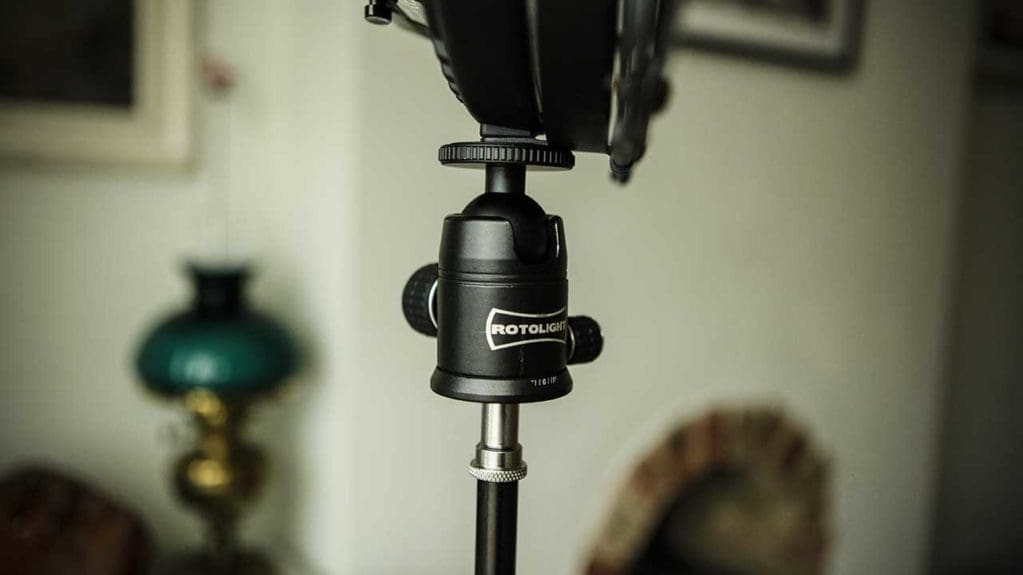
At full power the AEOS is able to produce an impressive 5750 lux at 3ft and the colour rendering of that light is CRI>96, Tlci 91 which Rotolight state is best in class. As well as the constant light the AEOS’s LEDs are also able to produce a flashlight and this supports High Speed Sync (HSS). When used as a flash the AEOS can be fitted with any normal wireless flash trigger or hardwired if you so wish.
Constant and flashlight in one unit is good but the AEOS also features a range of effects modes that will appeal to videographers, these enable you to simulate fire, lighting, TV illumination amongst a host of other effects. As with all Rotolight lights there’s also a range of filters that can be added for different effects and accessories such as barn doors that can be fitted to better control the light.
Power is supplied by either battery or mains, in the kit the mains is supplied and the battery is of the V lock type which would need to be purchased separately.
The first thing you notice about Rotolight products is the attention to detail and quality. Everything about the unit is tight in the design, nothing is there without a reason and the products really do mix style with utility.
Build quality and handling
Taking the AEOS out of the bag it only takes a couple of minutes to set-up. Our review unit arrived with a battery which keeps the unit small, compact and portable, but it’s worth noting that this is usually an additional cost. With the battery fitted the light is extremely easy to manoeuvre due to those two large handles on either side of the case.
Using the lamp with the mains adapter and the cable does, as always, get in the way, but without the weight of the battery it’s also that much lighter. Either way with or without the battery those two grips make it easy to position the lamp in the correct direction.
Of course holding the lamp for the duration of a shoot, stills, video shoot or otherwise isn’t really an option even if you do have assistant. Positioned around the outer edge of the AEOS are two tripod mountings with the standard 1/4-inch thread, this enables the light to be mounted to a stand or arm whenever needed.
These mounts can also be used to attach a series of accessories, in our kit I was supplied with the barn doors which are always handy when filming, less so for stills. Attaching these was exceptionally easy with neat slots enabling the doors frame to be slotted and tighten quickly.
Filters always play a big part in lighting, from dramatic coloured effects to a simple diffuser. Filters for the AEOS simply fit directly to the front of the unit and are rotated slightly to lock in place, a simple yet effective mechanism.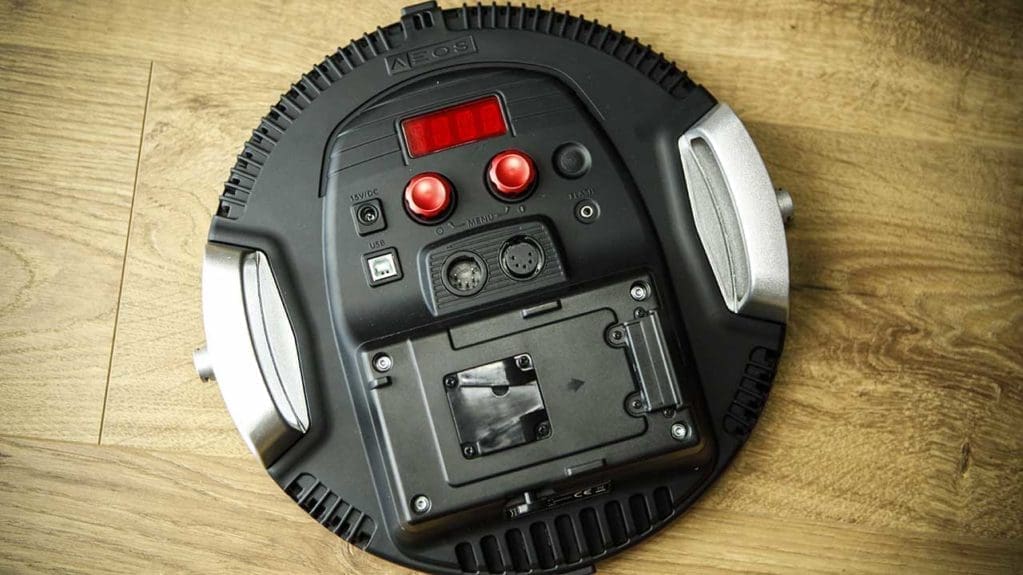
Rotating around to the back of the light and you see all the different control and input options.
At the top of the control panel is the small display, this is simple but effective showing you what mode you’re in, and the settings changes as you adjust the dials below. The two red dials enable you to quickly make adjustments, push both to access the main menu system and then each independently to adjust the light of the lamp.
The left dial adjusts the brightness and the right the colour temperature. One aspect that Rotolight are very keen to point out is the absolute accuracy of the lamps colour. If the lamp says it emitting 5600k light then you can be sure that it is. Although in the main test I only had one unit I did spend a day using two units mixed with a NEO, and set all the lamps to the same colour balance. When it came to checking over footage from the day it was very evident that there really was no shift in colour between any of the units.
The dials are made from metal and have a real quality feel and satisfying action when rotated that enables easy and accurate control over the power and temperature of the light.
There are several features of the AEOS that I wasn’t able to test due to limitations of my own kit which meant that I didn’t use the DMX ports, this is a high end feature and not something that I think at present many photographers will be using.
To the left of the dials is the mains power in, this used a pretty standard socket, at the beginning of the test I was a little worried that such a small connector plug could be an issue but the fit was snug and there was pretty much no way it would come loose on it’s own with someone tripping over the cable of course.
To the right of the dials is the power button and traditional flash sync port. This is of the standard 3.5mm design and easily attaches to almost any wireless flash trigger system that you could want.
Setting up the lamp ready for use as a flash is as easy as any other lighting system, just plug in the trigger set the power of the light and you’re ready to go.
Likewise if you want to use the effects, just select them through the menu and the lamp will run through a the pre-programmed option you have selected.
Performance
I find that lighting can be a real hassle for many reasons, usually shadows and catchlights.
The Rotolight AEOS instantly wins on both fronts with the diffused light of the AEOS creating a beautiful soft fall of light the just seems to help reduce the effects of shadows.
When it comes to catchlights the round design wins hands down when it comes to reflections in the eye when compared with the more common rectangular panel.
The fact that the Rotolight AEOS is round instantly puts you in a good place and then when you start to adjust the brightness and temperature you’re not having to mess around with lighting angles or reflectors to reduce that reflection.
The lamps design with the two large handles makes getting the lamp into position exceptionally easy. I must admit if i buy a set, and it would be a set, then I would have to stretch to the batteries as well as it made the lamps that much more versatile and of course portable.
The AEOS is one of a new generation of lamps designed for use by both stills and video photographers, but obviously the way the two disciplines use lighting is quite different.
Starting with video the ability to fine tune the colour temperature of the lamp to your surroundings really does help to save time in post processing. When used in combination with an X-Rite color chart it’s quick and easy to balance colour.
Using one light in isolation for video with the diffuser attached created a nice soft light with power enough to comfortable illuminate the subject. The quality of light emitted meant that the fall of light created attractive catchlights in the eyes. Any soft shadows that do can be easily subdued with a secondary light in the background.
Although I didn’t use the effects modes in earnest, I had a good experiment with the effects and as with using the constant lighting adjustment the effects are all easy and pretty self explanatory.
At the moment you are isolated to the effects that are pre-programmed into the AEOS and there is no way to create your own, but this could possibly be something that will change in the future.

Using the illumination for photography the powerful LEDs emit a good amount of light for anyone who has made the switch from flash to constant.
Again the ease of brightness and temperature control enable quick and easy adjustment when it comes to the intensity and effect of the lighting.
Photographers will also benefit from the ability to easily attach filters to the front of the lamp in order to create different coloured lighting effects, these can be especially handy when shooting for fashion.
Of course the big features here with the AEOS is the fact that it has the ability to flash, and as it uses LEDs to do this rather than a flash tube therefore recycle times are zero.
This means that the AEOS has ultra fast HSS flash sync so it can be used with a max sync speed of 1/8000th of a sec. Used as a flash the power ramps up to 200% of the continuous maximum output. Whilst this is powerful it’s not as powerful as a dedicated flash.
But then at the size, weight and spread of the light it does more than an acceptable job of illuminating the subject.
Rotolight have added a wireless flash sync port so that the AEOS can be used with any third party flash triggers and this gives the whole unit a more tradition feel when in use.
The power of the flash might not equal a tradition studio flash but when lighting models when do you ever use the flash at full blast. In the test the amount of light the LED produced was more than sufficient for a standard portrait shoot.
Verdict
There’s no doubt that the AEOS has a tonne of potential. As yet there are no other lights on the market that come close to the specifications or flexibility of use that’s offered by Rotolights latest offering.
As a video light coupled the relatively compact size and power make them an attractive option for location work, as long as you purchase the battery.
The design with plenty of mounting options and large accessory list also means that there’s a huge amount of flexibility when it comes to their use and tailoring to your style of shooting.
The twin dial control and small LED panel make for easy adjustment during filming and the effects options are superb for adding a touch of drama or atmosphere to your shots.
Used as a light for still photography and the constant LEDs are powerful enough to throw enough light to illuminate your subject effectively.
Add in the power of the flash and this greatly adds to the versatility of the unit.
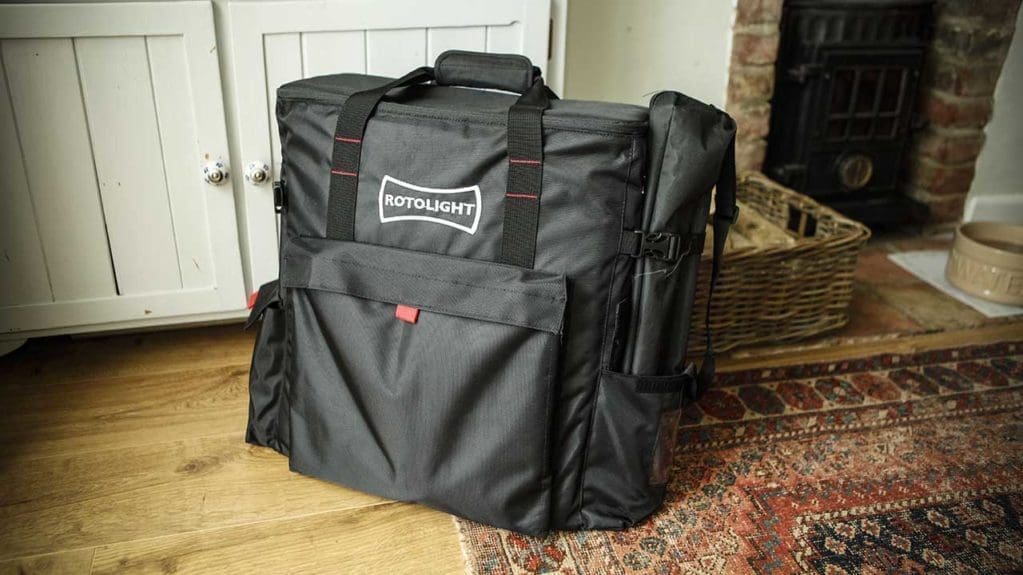
At present there really is little else to compete with the Rotolight AEOS and as the demands on photographers to shoot video as well as stills increases the need for a solution such as the AEOS will only increase.
Size and weight wise there really is little difference between the AEOS and a more traditional set of decent studio flash lights.
In today’s demanding world the AEOS delivers an attractive lighting solution for the Semi-Pro and Pro photographer. A two lamp set will set you back £1900 and then another £600 for two batteries with chargers, so all in £2500.
That might seem a lot but then for a lighting system that will effectively cover you for both stills and video work that’s a pretty decent price.
Would I buy one, maybe, would I buy two yes..
